ELEMENTARY SURVEY AND MAP MAKING
Meaning and Types of Survey
Types of Simple Land Survey
Explain the types of simple land survey
Surveying
can be categorized into various types or branches depending on its
purpose, function and nature. There are two main types of surveying,
namely plane and geodetic surveying.
1. Plane surveying
Plane
survey is the most commonly practised method of surveying and treats
the Earth as a flat or "plane" surface. A good thing is that for
small-scale surveys in limited areas, the curvature of the Earth has no
effect on the results.
2. Geodetic surveying
Geodetic
surveying is the survey in which the curvature of the Earth is taken
into account and a higher degree of accuracy in linear and angular
observations is achieved. The geodetic surveys extend over large areas
and lines connecting any two points on the surface of the Earth are
treated as arcs.
The table below outlines the differences between plane surveying and geodetic surveying.
Table 4.1 Differences between plane surveying and geodetic surveying
| Plane surveying | Geodetic surveying |
| Effect of the curvature of the Earth surface is ignored. | Effect of the curvature of Earth surface is considered. |
| In plane surveying, the line joining any two points of a triangle formed by any three points is considered as a straight line and plane triangles are assumed to be plane angles. | In geodetic surveying, the line joining two points of a triangle formed by three points is considered as a curved line of spherical triangle and angles of a triangle are considered as spherical angles. |
| This survey is done on a small area less than 250 km2. | This survey is done on a large area greater than 250 km2. |
| Level of accuracy is comparatively low. | High accuracy is required. |
| Simple methods and instruments can be used as the required accuracy is low. | Very refined methods and instruments are used. |
| The Earth surface is assumed to be plane, i.e. two dimensional. | The Earth surface is assumed to be spherical, i.e. three dimensional. |
| Done locally by the individual organization. | Done by the concerned state or government department. |
From
the two main types of land survey explained above, there may be many
categories of survey. This means that these categories can be either
geodetic or plane surveying depending on whether the curvature of the
Earth is taken into account or not. They include the following
categories:
(a) As-built survey
This
is a survey carried out during or immediately after a construction
project for record, completion evaluation, and payment purposes. For
example, after engineers have completed constructing a building or road,
they have to survey the infrastructure before they are paid. This will
enable to tell whether the design before construction is the same as the
design after construction, especially designs of buildings, bridges and
the like.
(b) Cadastral or boundary surveying
This
is a survey that establishes or re-establishes boundaries, for example,
boundaries of villages, districts, regions, or countries.
(c) Engineering surveying
This
is a survey associated with the engineering design often requiring
geodetic computations beyond normal civil engineering practice.
Engineering surveying is an important disciplinary field that serves
construction projects.
Examples
of construction projects that require professional services of
engineering surveyors include projects in which buildings, highways,
railways, tunnels, bridges and harbours are constructed.
(d) Structural surveying
This
deals with a detailed inspection to report upon the physical condition
and structural stability of a building or other structure and to
highlight any work needed to maintain it in good repair.
(e) Topographic surveying
This
is a survey that deals with measurements of physical features of the
Earth’s surface. It is a survey that measures the elevation of points on
a particular piece of land, and presents them as contour lines on a
plan.
Chain Survey
Types of Equipment used in Chain/Tape Surveying
Explain different types of equipment used in chain/tape surveying
To
conduct chain survey successfully, a number of different equipment is
used. The equipment used in chain survey include the following:
(a) Chain
A
chain is used to measure short, linear distances on the field. It is
made up of connected steel segments, or links, each with a length of 20
cm. Sometimes brass plates are attached at every 5 m length to serve as
joint or tally markers. A chain can be 20, 25 or 50 metres long,
including one handle at each end.

Fig 4.3 A chain
(b) A tape
Measuring
tapes or tape measures are made of steel, coated linen, or synthetic
material. They are available in lengths of 20, 30 and 50 m. Centimetres,
decimetres and metres are usually indicated on the tape. Just like
chains, tapes are used to measure short, straight distances.

Fig 4.4 A measuring tape
(c) Measuring rod
A
measuring rod is a straight piece of wood with a length varying from 2 m
to 5 m. The rod is usually marked in the same way as a measuring tape,
indicating centimetres, decimetres and metres. The rod is used for
linear measurements.

Fig 4.5 A measuring rod
(d) Plumb line
A
plumb line is used to check if objects are vertical. A plumb line
consists of a piece of metal (called a plumb bob or plummet) pointing
downwards, which is attached to a string. When the plumb bob is hanging
free and not moving, the string is vertical.
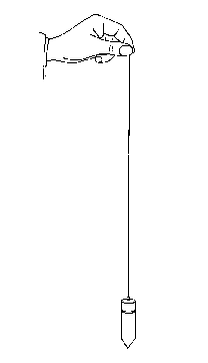
Fig 4.6 A plumb line
(e) Spirit level
A
spirit level, also known as carpenter level, is used to check if
objects are horizontal or vertical. Within a spirit level there is/are
one or more curved glass tube(s), called level tube(s).

Fig 4.7 A spirit level
Each
tube is sealed and partially filled with a liquid (water, oil or
paraffin). The remaining space is air, visible as a bubble. On the glass
tube there are two marks. Only when the spirit level is horizontal (or
vertical) is the air bubble exactly between these two marks (Fig. 4.8).
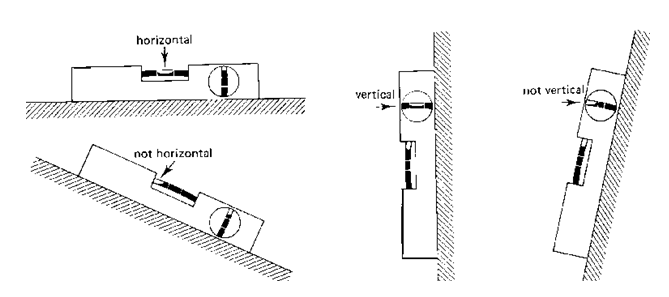
Fig 4.8 Use of spirit level
(f) Ranging poles
Made
up of wood or light metal, ranging poles are used to mark stations and
to set out straight lines on the field. They are also used to mark
points which must be seen from a distance, in which case a flag may be
attached to improve the visibility.
Ranging
poles are straight, round stalks, 3 to 4 cm thick and about 2 m long.
They are made of wood or metal with pointed steel heads for sticking
into the ground. Ranging poles can also be home-made from strong,
straight bamboos or tree branches.
Remember
that ranging poles may never be curved. Ranging poles are usually
painted with alternate red-white or black-white bands so that they can
be easily seen even from a distance. If possible, wooden ranging poles
are reinforced at the bottom end by metal points.
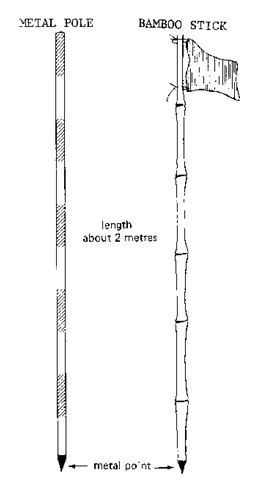
Fig 4.9 Ranging poles
(h) Pegs
Pegs,
generally made of wood, are used for permanently marking positions
during survey. Sometimes pieces of tree branches, properly sharpened,
are good enough. The size of the pegs (40 to 60 cm) depends on the type
of survey work they are used for and the type of soil they have to be
driven in. The pegs should be driven vertically into the soil and the
top should be clearly visible.

Fig 4.10 Wooden pegs
(i) Arrows
Arrows
are made of steel wire of diameter 4 mm. They are used for marking the
end of each chain length during the process of chaining. The arrows are
pointed at one end and coiled or rounded at the other end where a rag or
tag can be tied to make them more visible.
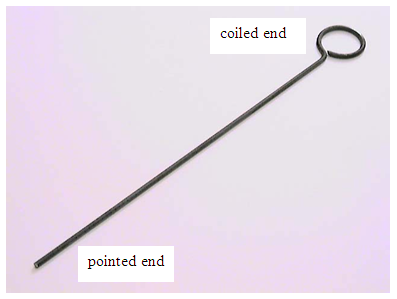
Fig 4.11 An arrow
(j) Cross staff
This
is a cross fitted on a short ranging pole used for setting out right
angles from the line. It can be made of wood or steel and has eye slits
at right angles.
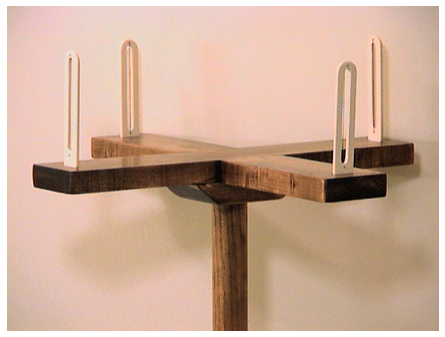
Fig 4.12 A cross staff
(k) Optical square
An
optical square is a hand-held instrument used to set out right angles.
It employs two mirrors at a 45° angle. It is used for marking offsets at
right angles from the line. The term offset refers to the lateral
distance of an object or ground feature measured from a survey line.
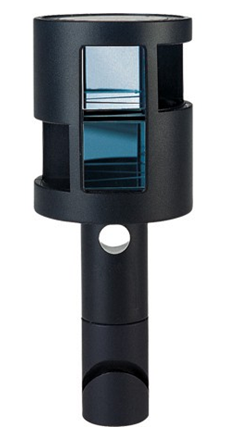
Fig 4.13 An optical square
(l) Field notebook
A notebook is used for recording all necessary field work information.

Fig 4.14 A notebook
(m) A hard pencil and a rubber
Hard
pencils are used for drawing in the field and a rubber is used to erase
mistakes or errors which are made. A pencil should be HB or HHB.
The other equipment used in chain survey include a compass and surveyor’s band.
Chain/Tape Surveying Activities at School Level
Practice chain/tape surveying activities at school level
Chain
survey, as a science and art, is conducted by adhering to certain
procedures for the best outcome. The entire operation of chain survey
can be divided into three major groups namely, inspection of the area,
surveying in the field and presentation of data or recording. Given the
appropriate instruments and supervised by a teacher, surveying can also
be done at school level. The procedures for survey are explained below.
1. Inspection of the survey area (Reconnaissance)
The
preliminary inspection of the area to be surveyed is called
reconnaissance. The first step in conducting a survey is to inspect the
area to be surveyed. This includes preparing index sketch or key plan.
Note details like roads, buildings, canals, ditches, culverts and the
difficulties and obstacles that may arise during survey.
It
is important to give a north line on the rough sketch and though the
sketch is not prepared according to the scale, it should represent the
approximate positions of the different things in the plot and hence to
be a good guide for further work.
Inspection of the site for survey may involve the following:
- Walk over and inspect the area to be surveyed and thoroughly examine the ground, note the position of boundaries, road, and river etc., and various obstacles to chain lines. Prepare neat sketches called index sketches or key plan.
- Estimate the maximum dimensions of the survey area, either by rough tape measuring or by pacing. This will help when working out the scale.
- Select survey stations and survey lines: Stations are points on the ground fixed by driving pegs. Every station should be located with respect to three permanent objects i.e. the distances from these objects to the stations should be measured very accurately and recorded in the field book. The advantage of taking this measurement is that if in future the peg at the station is lost, then it can be located again by knowing descriptions and distances of these objects.
The selection of a particular station depends upon the fallowing important considerations:
- The triangle should be a well-defined one, i.e. nearly equilateral triangle.
- There should be a minimum number of obstacles in ranging and chaining.
- The chain line should run near the boundary of the plot.
- Offsets should not exceed one chain.
- Check and tie lines should be provided in sufficient number so that all the main lines, offsets and other details can be checked thoroughly.
- Adjacent stations should be intervisible so that ranging can be done easily.
- Make sure lines joining adjacent stations pass through a level open ground as far as possible so that chaining can be done easily.
- Survey lines should be as few as possible so that framework of triangles can be plotted easily. The lines are sited where they can be used to pick as much detail as possible.
- Ensure distances between station points are known (can be measured using chain or tape and recorded on a field book).
- Stations should be recorded by assigning them numbers or letters for identification.
- The main survey lines should form well conditioned triangles with no angles less than 30° or more than 120°.
A
tie line is one which connects two points on the two main lines of the
triangle. It helps in taking offsets of the objects falling within the
triangle and which are too far away from the main line.
A
check line is also a tie line which helps in checking the accuracy of
the work after plotting in a drawing sheet. A check line or tie line is
never extended beyond the main lines.
An offset is the lateral distance of an object or ground feature measured from a survey line. The two types of offsets are:
- Perpendicular offset: The angle of offset from a point on a chain line is 90º.
- Oblique offset: When the angle of offset is other than 90º.

2. Surveying in the field
A
survey team involves three people, the leading chainman or leader, the
follower and the booker. The follower is in charge of measurements while
the booker records all data in the field notebook. The chain is thrown
to extend it and disentangle any knots. The leader takes ten arrows and a
ranging rod, and the follower takes a ranging pole. The follower erects
his ranging pole at the first base point and places a brass handle of
the chain against the ranging pole. A leader straightens the chain and
inserts an arrow at the other end of the brass handle. Offsets and tie
lines can now be taken. The leader drags the chain so that the
follower’s end is on the leader’s arrow. The follower moves to another
point and places his ranging pole behind the arrow. This procedure is
then repeated as measurements are recorded by the booker.
Generally, during actual survey, the following should be observed:
- In the case of chaining along the road, it is always better to run chains on one side of the road to avoid interruptions by vehicles. It is better not to cross the road frequently.
- The frame should have at least one long baseline that runs through the middle of the area.
- If required, number of subsidiary stations should be selected and subsidiary lines run to avoid long offsets.
- While selecting main stations and survey lines, the basic principles of surveying involving working from whole to the part should be followed.
3. Presentation of data or recording
After
the field has been surveyed, all the information gathered during the
exercise (data) is recorded in a notebook. It presented in a manner that
can be understood by others. The data is represented in the form of
maps, plans, or diagrams. These are recorded on the drawings by:
- scale presentation;
- use of conventional signs;
- tabulation of notes; or
- measured and calculated data.
The best method chosen depends on the nature of the survey work.
The Importance of Survey
Explain the importance of survey
Land
surveying is a very important profession for social and economic
development. The points below describe the importance of land survey.
- It is important in land use planning, which includes town mapping, civil engineering, structural engineering, and architecture.
- It is used to fill in details on a map whose large features have been surveyed by other methods.
- It is used in mapping small areas of flat or near-flat ground and associated objects, for example paths, roads and railways.
- It is used in adding detail to existing plans or large maps.
- It helps to find the relative positions and sizes of features on the land surface.


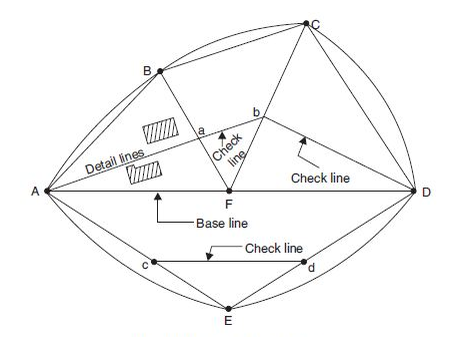



No comments